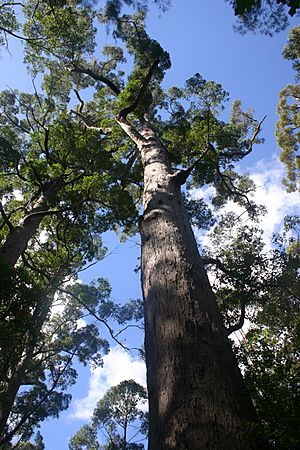Tingle trapdoor spider facts for kids
Quick facts for kids Tingle trapdoor spider |
|
|---|---|
| Scientific classification | |
| Synonyms | |
|
Moggridgea tingle Main, 1991 |
The Bertmainius tingle, also known as the tingle trapdoor spider, is a small spider. It lives only in the tingle and karri forests of southwestern Western Australia. This type of spider was first found in the 1990s. It belongs to a group of spiders called migids.
Contents
About the Tingle Trapdoor Spider
The tingle trapdoor spider is quite small. It is less than 10 millimeters long. The female spider's main body part, called the carapace, is about 2.6 to 3.1 millimeters long. Its body and legs are black and shiny.
Discovery and Naming
Spiders from the Migidae family in Western Australia were not known until 1990. Dr Barbara York Main first described and named this spider in 1991. She placed it in a group called Moggridgea. The B. tingle spider was found by accident. A scientist was looking at another bug and some tree bark in a lab. When the bark was being thrown away, the spider came out! Its name, "tingle," comes from the tingle tree where the bark was found.
Later, in 2015, a scientist named Mark Harvey and his team moved this spider to a new group called Bertmainius. They did this because the spider looked very different and its DNA was also unique.
Where the Tingle Trapdoor Spider Lives
This spider is found in two places inside the Walpole-Nornalup National Park. It lives in the soil or in the bark of the red tingle tree (Eucalyptus jacksonii). The spider's home is in the tingle and karri (Eucalyptus diversicolor) forests. These forests are in a special area called the Warren region. This area is a biodiversity hotspot, meaning it has many different kinds of plants and animals. Some of these species are very old, like those from the ancient continent of Gondwana. Other spiders from the Bertmainius group have also been found in southwestern Australia.
Life and Habitat
The Bertmainius tingle spider lives in the topsoil or in the stringy bark of the red tingle tree. It builds nests that look like silk tubes. These tubes can be up to 20 millimeters long. They have an opening at the surface of the bark or soil. This opening has a special "trapdoor" cover. The trapdoor is made from moss, bark, and the spider's own silk. These spiders like to live in places that are damp and shady.
Threats to the Spider
The tingle trapdoor spider is in danger from fires and from its home being destroyed. This can happen when new roads are built. There are plans to help protect the spider's home during fire management. This includes controlled fires, also known as 'prescribed burns'. Because its home is being destroyed, the tingle trapdoor spider is considered an endangered species.


